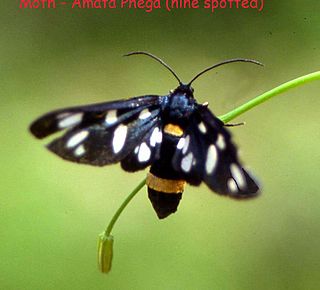
Amata is a genus of tiger moths in the family Erebidae. The genus was erected by Johan Christian Fabricius in 1807.

Cyanopepla is a genus of moths in the subfamily Arctiinae. The genus was erected by James Brackenridge Clemens in 1861.
Amata expandens is a species of moth of the family Erebidae first described by Francis Walker in 1862. It is found in Sundaland. The habitat consists of lowland areas.

Amata huebneri, the wasp moth, is a moth in the genus Amata of the family Erebidae. The species was first described by Jean Baptiste Boisduval in 1829. It is found from the Indo Australian tropics to northern Australia.
Amata humeralis is a species of moth of the family Erebidae first described by Arthur Gardiner Butler in 1876. It is found in Australia, where it has been recorded from Western Australia, the Northern Territory, Queensland and New South Wales.
Amata marella is a species of moth of the family Erebidae first described by Arthur Gardiner Butler in 1876. It is found in Australia, where it has been recorded from Queensland.
Amata melitospila is a species of moth of the family Erebidae first described by Alfred Jefferis Turner in 1905. It is found in Australia, where it has been recorded from Queensland.
Amata nigriceps is a species of moth of the family Erebidae first described by Arthur Gardiner Butler in 1876. It is found in Australia, where it has been recorded from Queensland and New South Wales.
Amata paraula is a species of moth of the family Erebidae first described by Edward Meyrick in 1886. It is found in Australia, where it has been recorded from the Northern Territory and Queensland.
Amata pactolina is a species of moth of the family Erebidae first described by Francis Walker in 1865. It is found in Australia.
Amata xanthura, the southern spotted tiger moth, is a species of moth of the family Erebidae. It was first described by Alfred Jefferis Turner in 1905. It is found in Australia, where it has been recorded from the Northern Territory, New South Wales and Victoria.
Amata annulata is a species of moth of the subfamily Arctiinae first described by Johan Christian Fabricius in 1775. It is found in Australia, New Guinea and the Philippines.
Amata aperta is a species of moth of the family Erebidae first described by Francis Walker in 1865. It is found in Australia and New Guinea.
Amata decorata is a species of moth of the family Erebidae first described by Francis Walker in 1862. It is found on Borneo. The habitat consists of lowland areas.
Castulo plagiata, the yellow-banded footman, is a moth of the subfamily Arctiinae. The species was first described by Francis Walker in 1854. It is found in the Australian states of New South Wales, Victoria and Tasmania.
Amata simplex is a moth of the family Erebidae. It was described by Francis Walker in 1854. It is found in the Democratic Republic of the Congo and South Africa.

The Syntomini are a tribe of moths in the family Erebidae. The tribe was erected by Gottlieb August Wilhelm Herrich-Schäffer in 1846.



